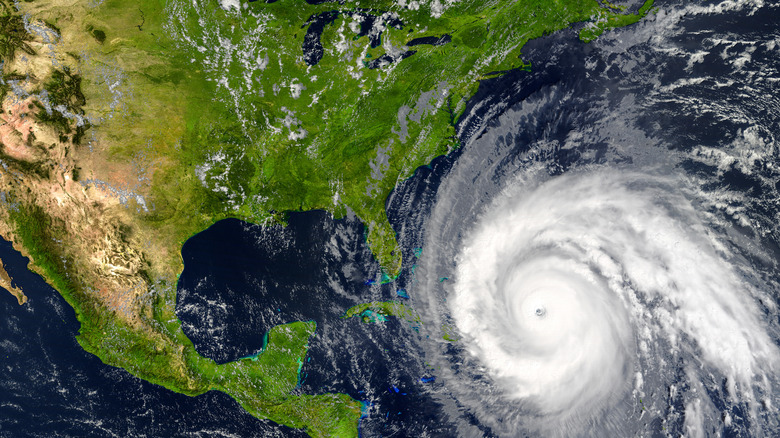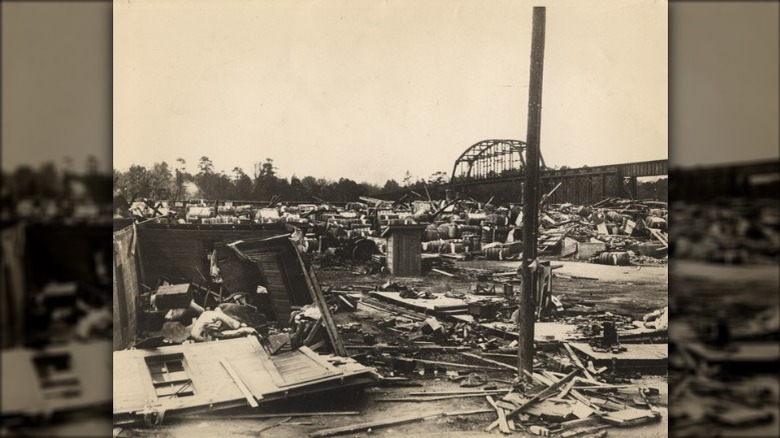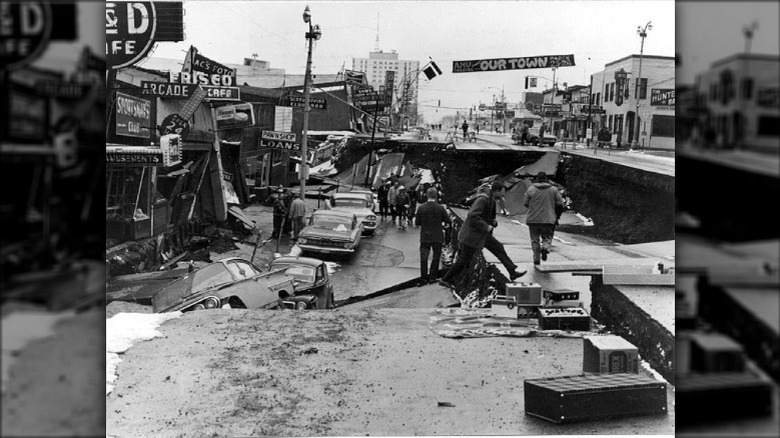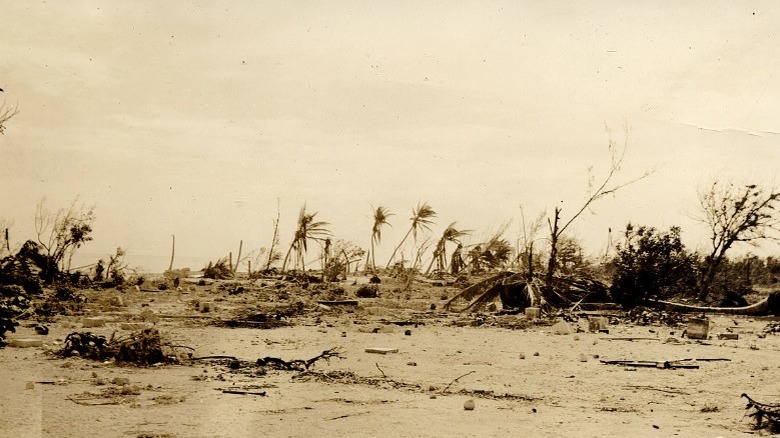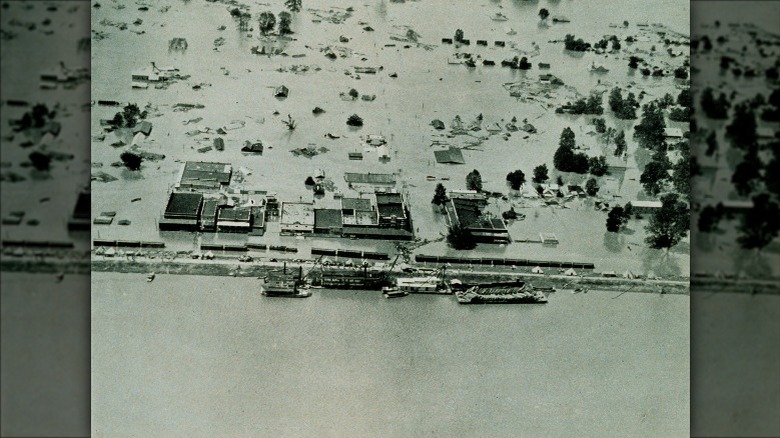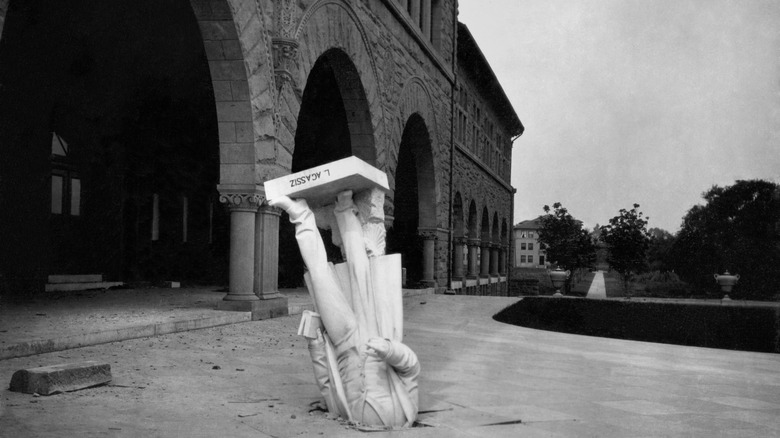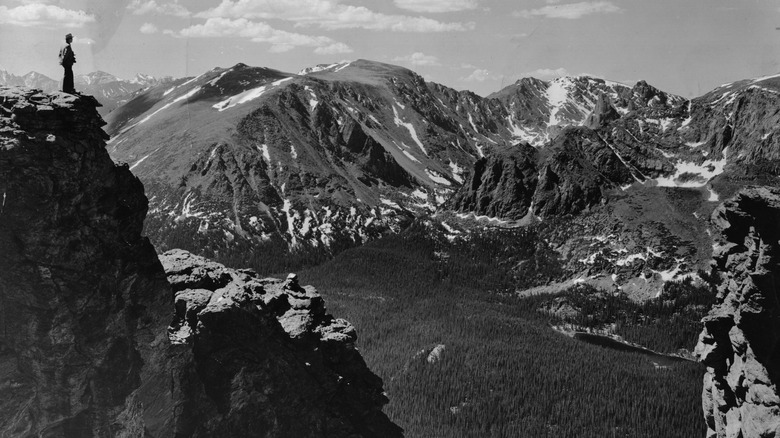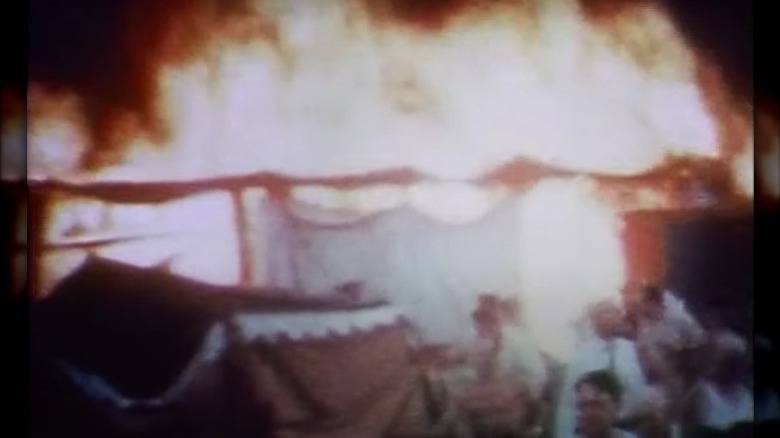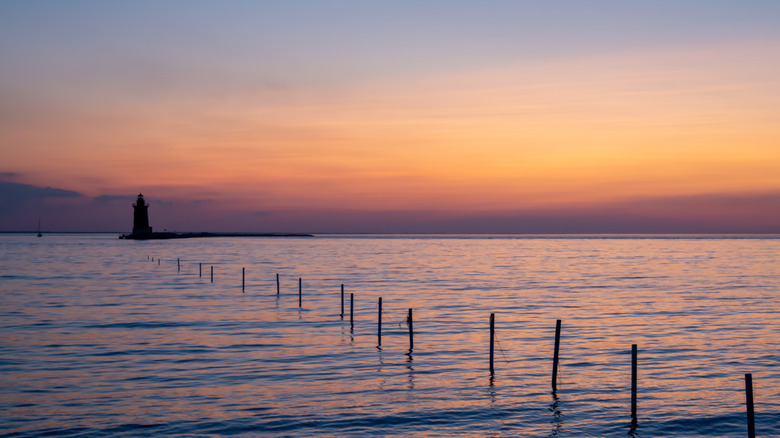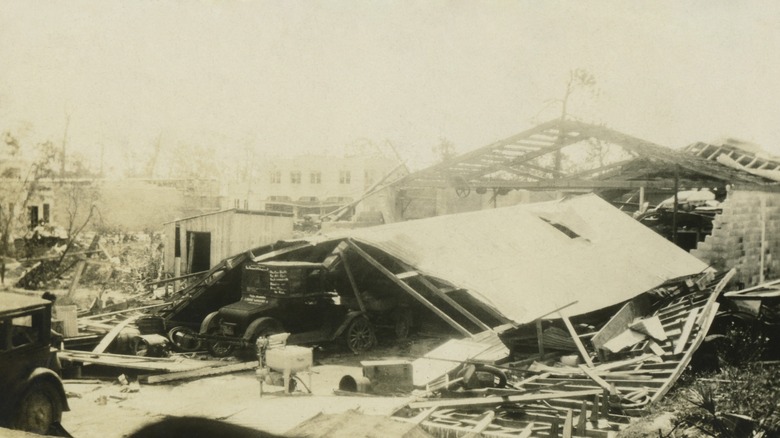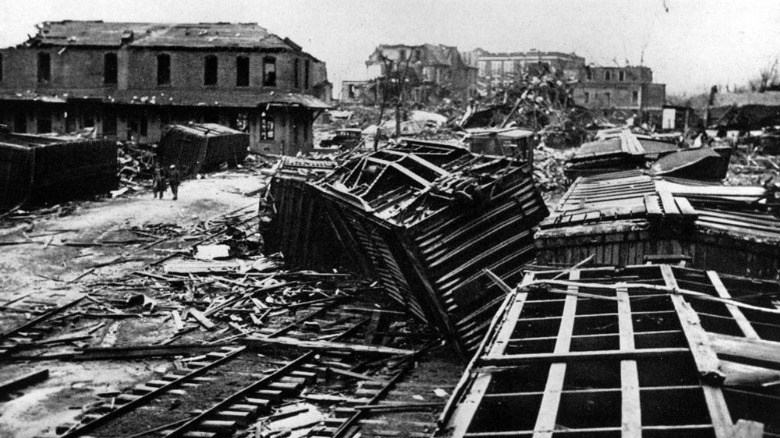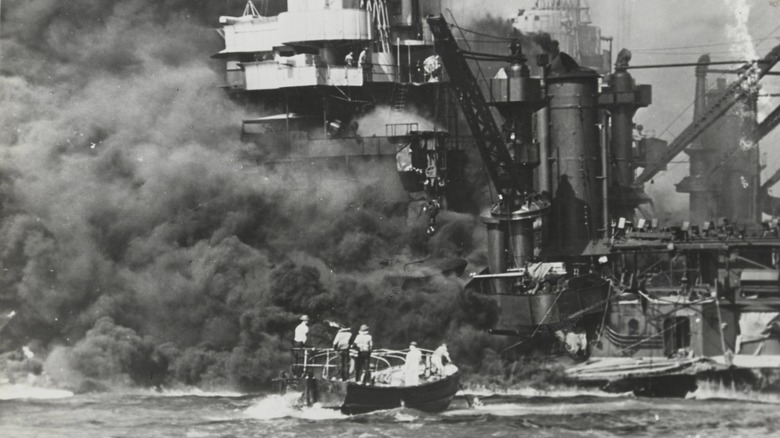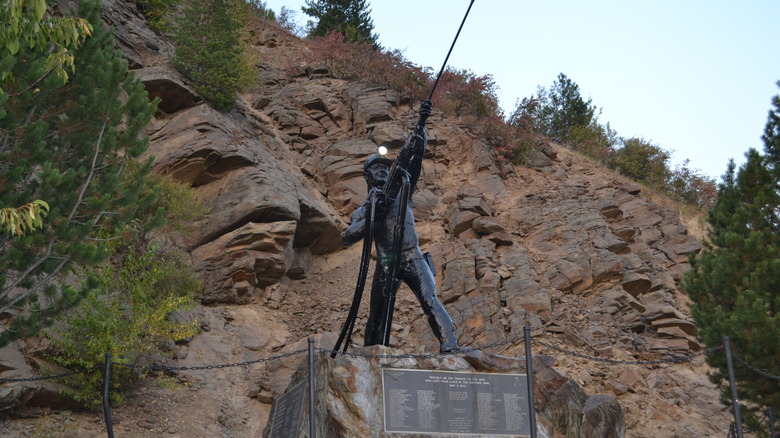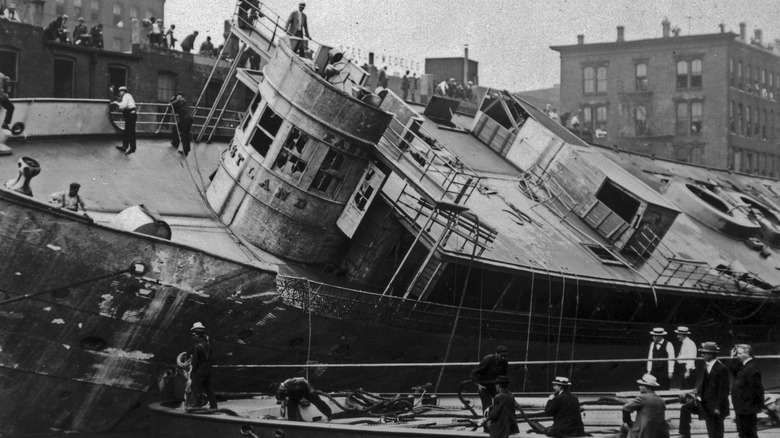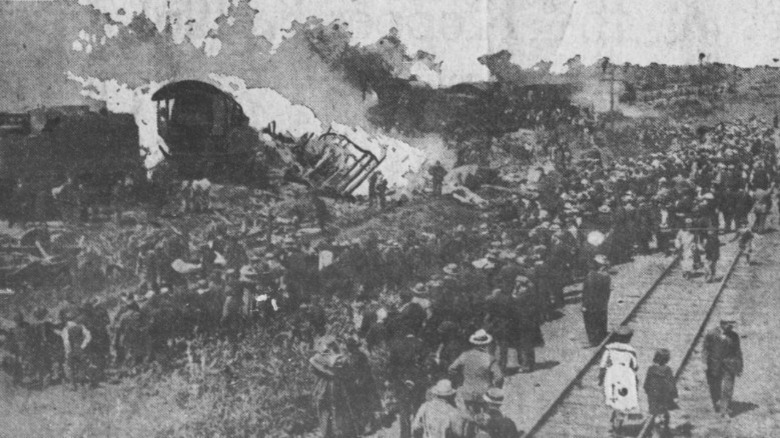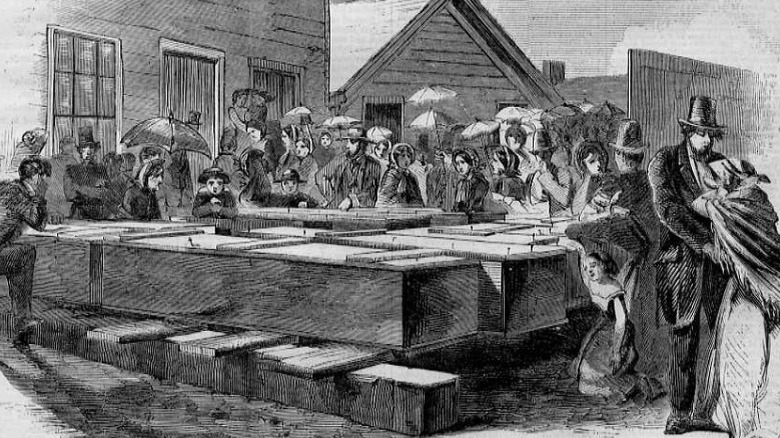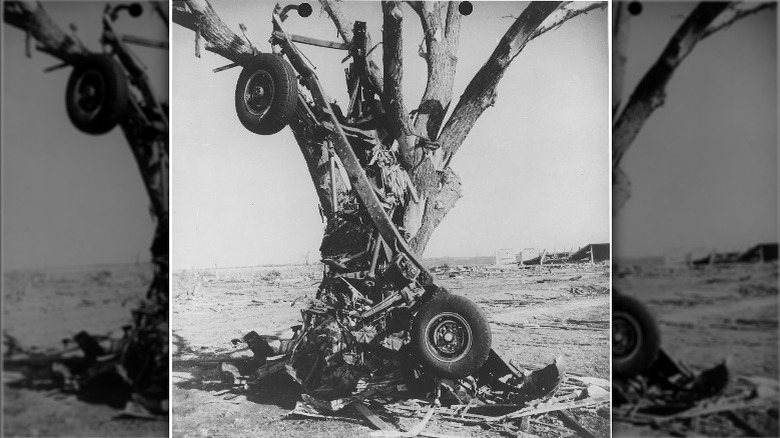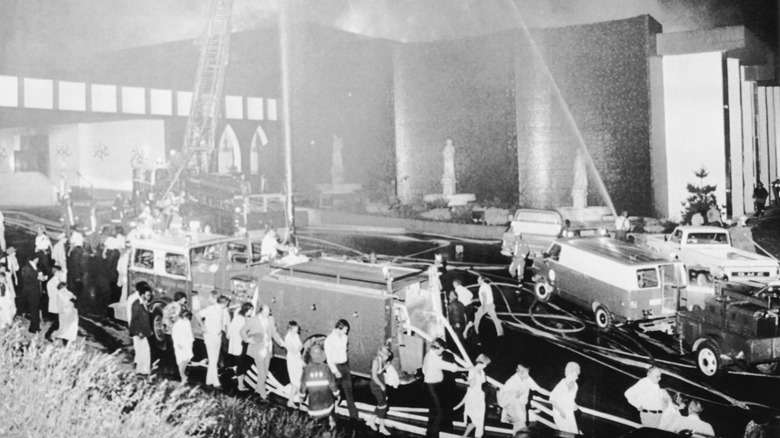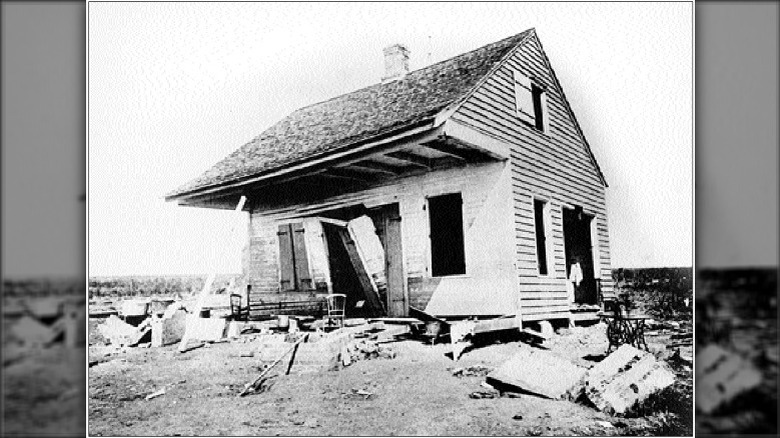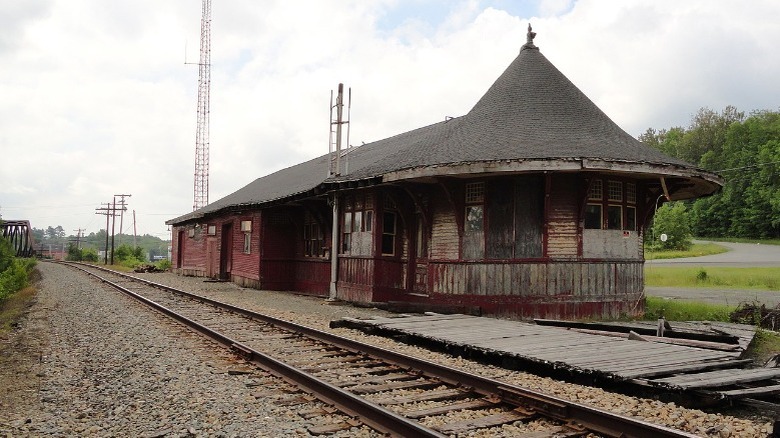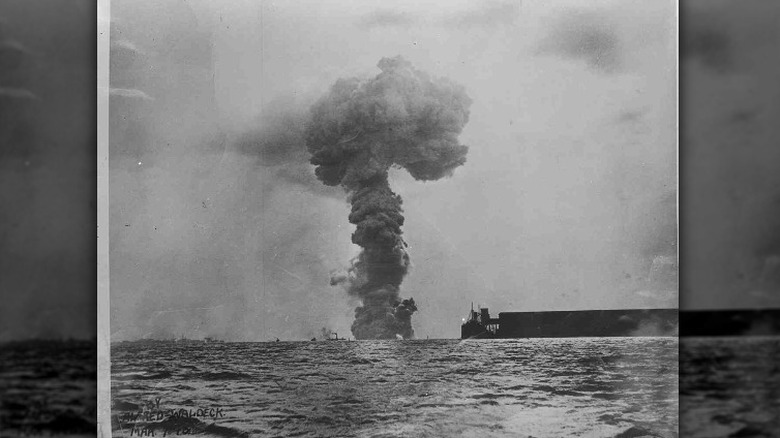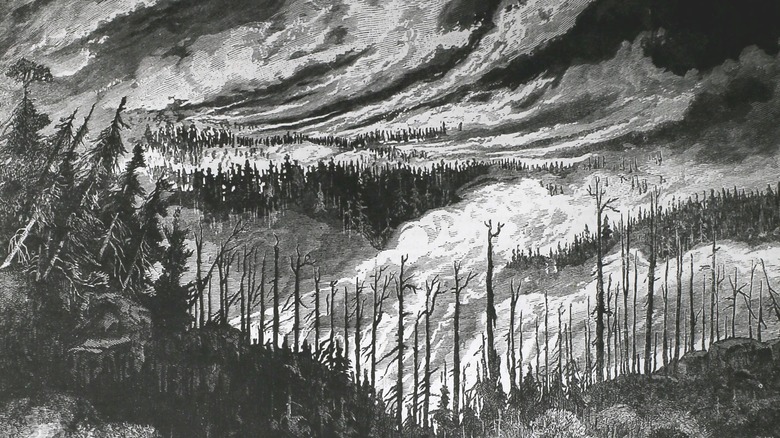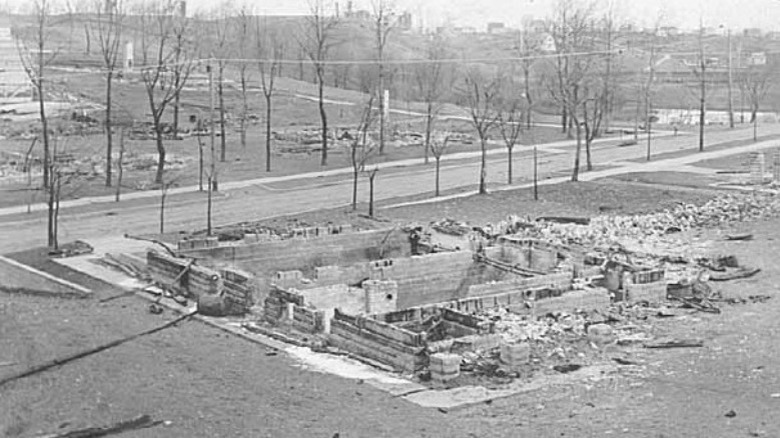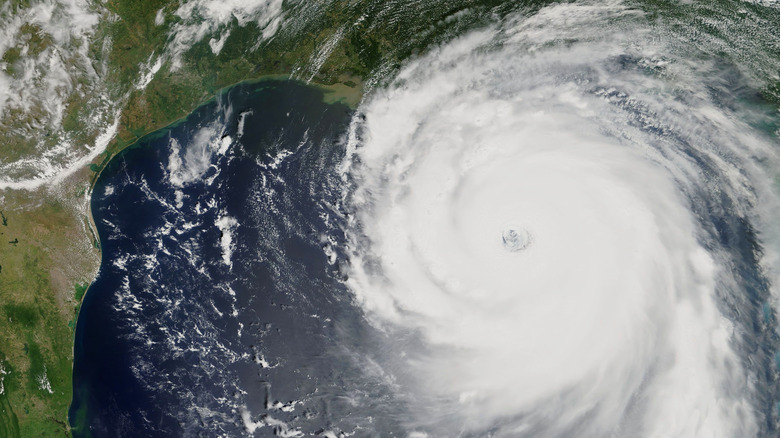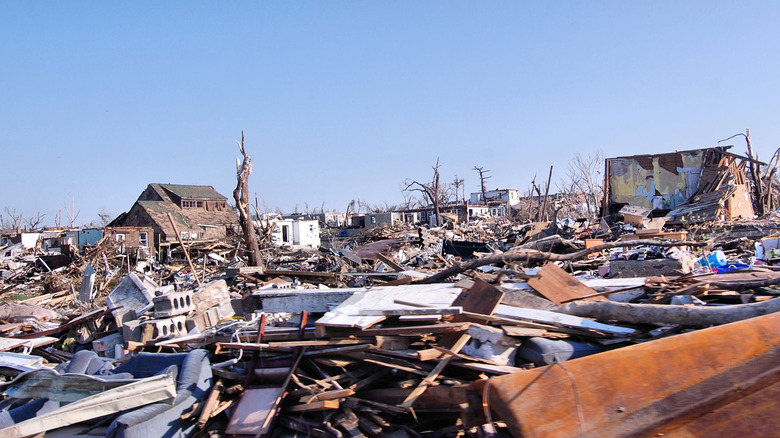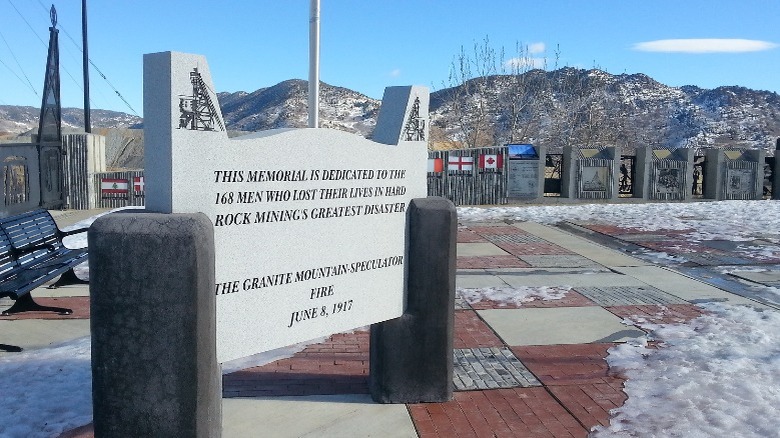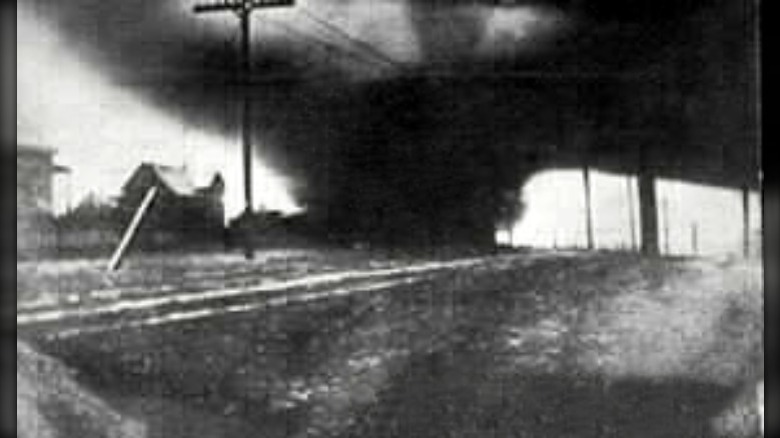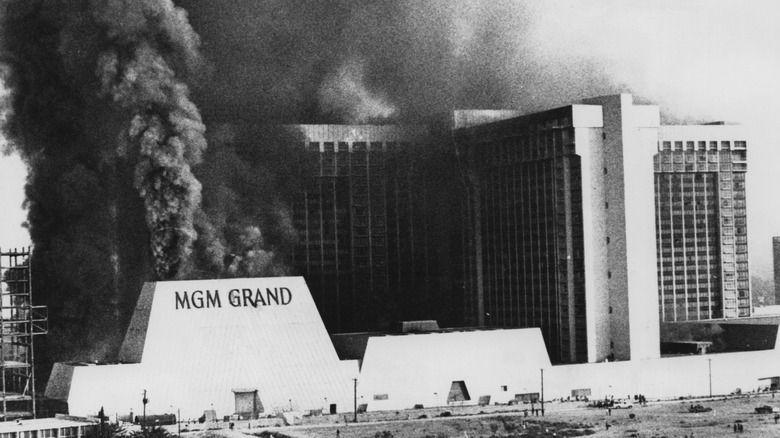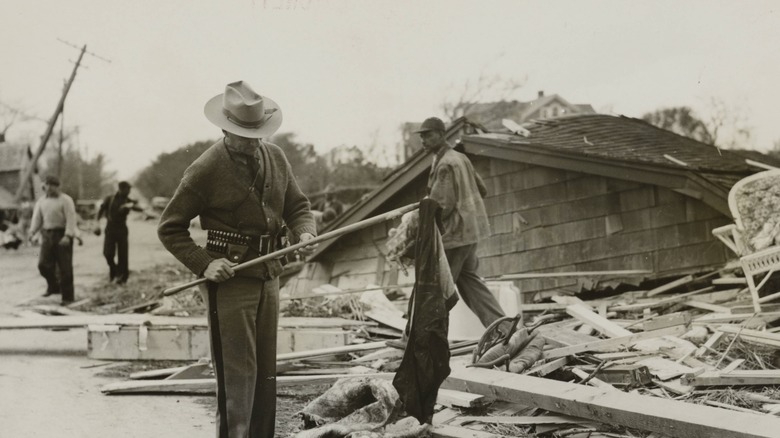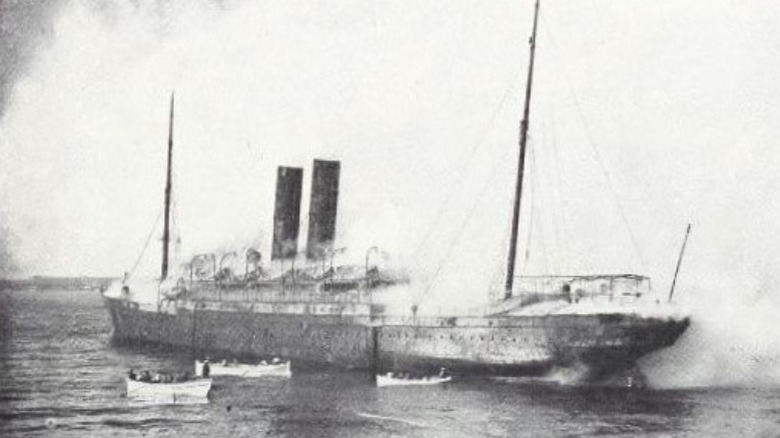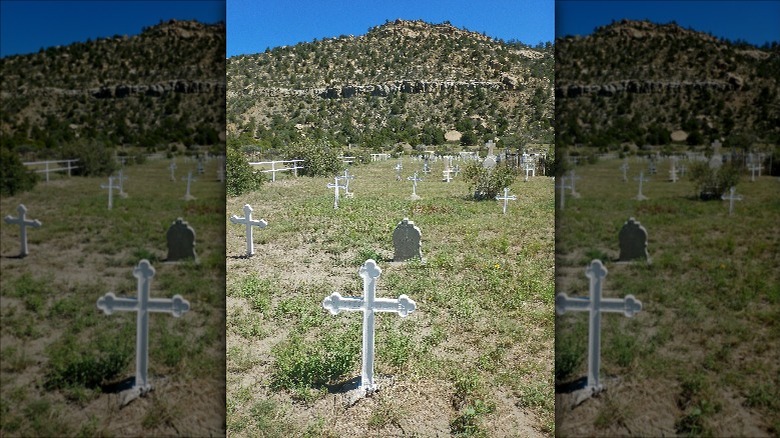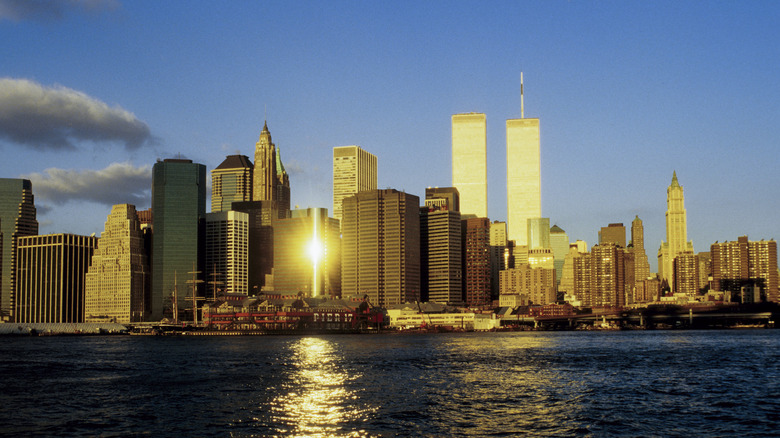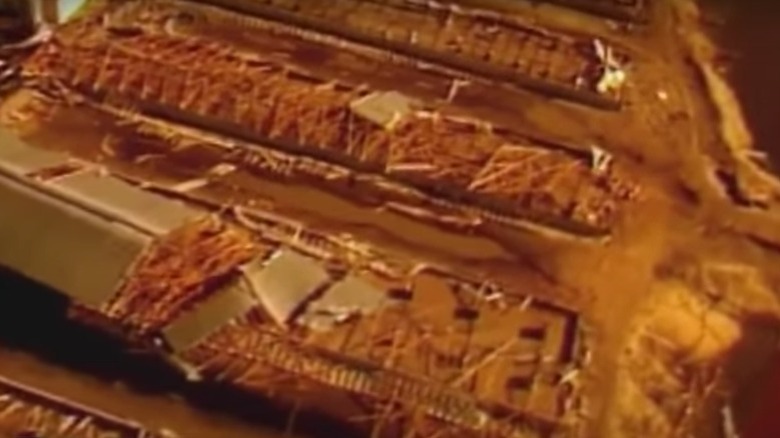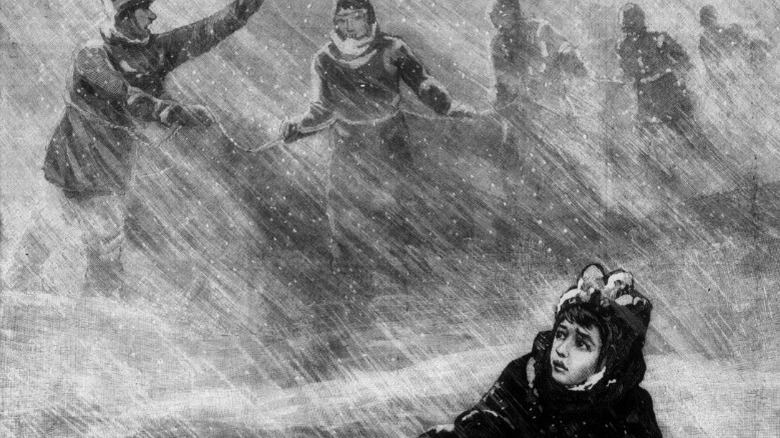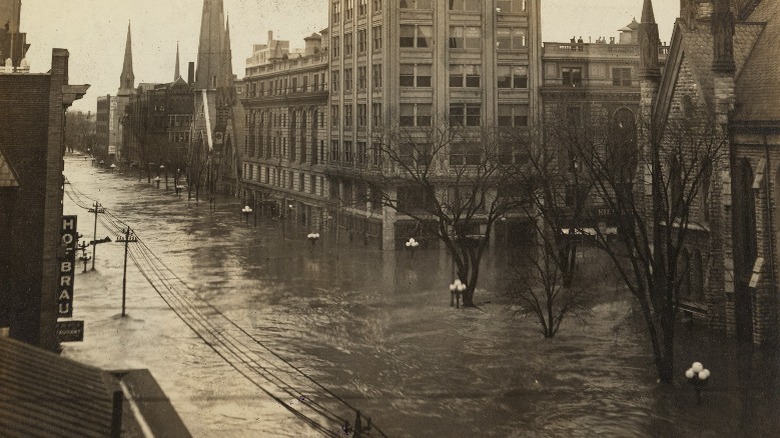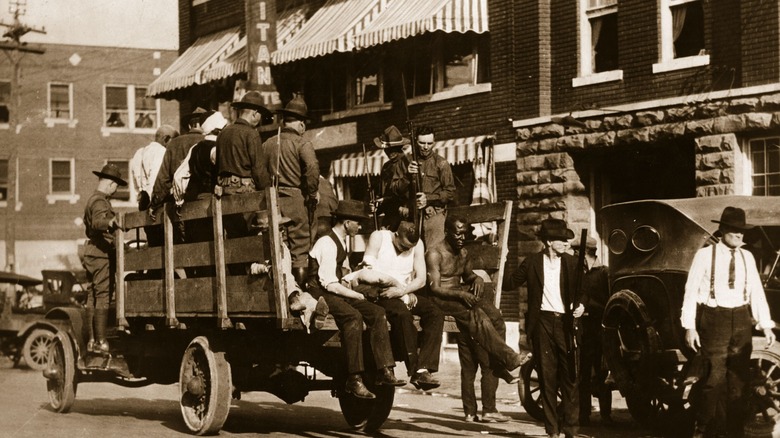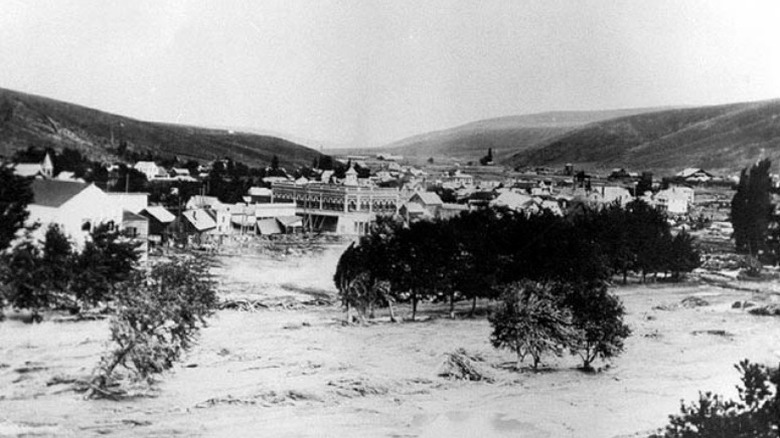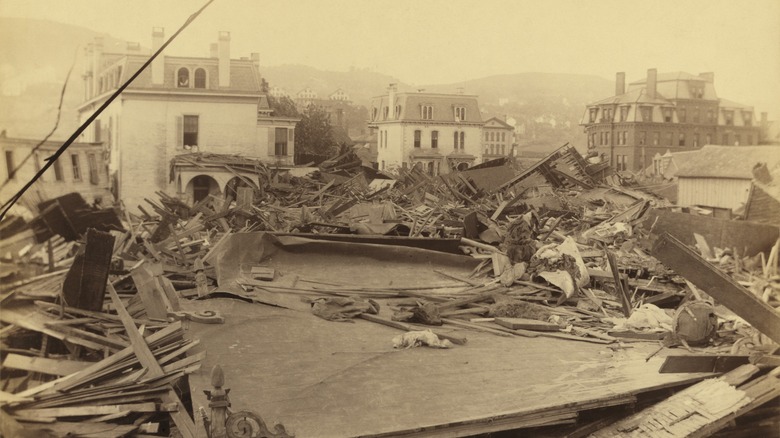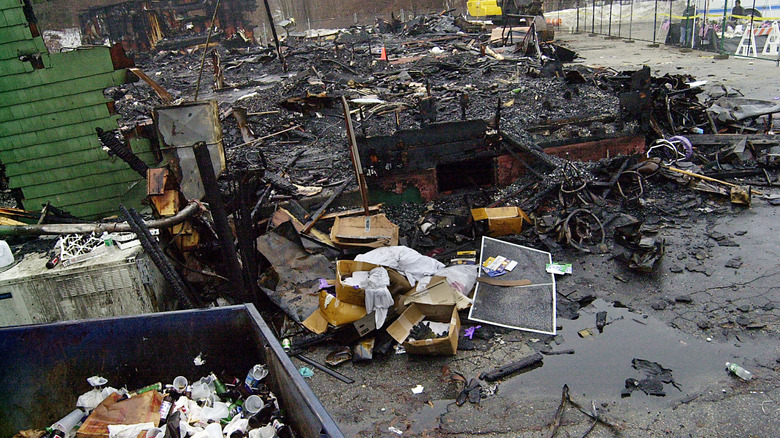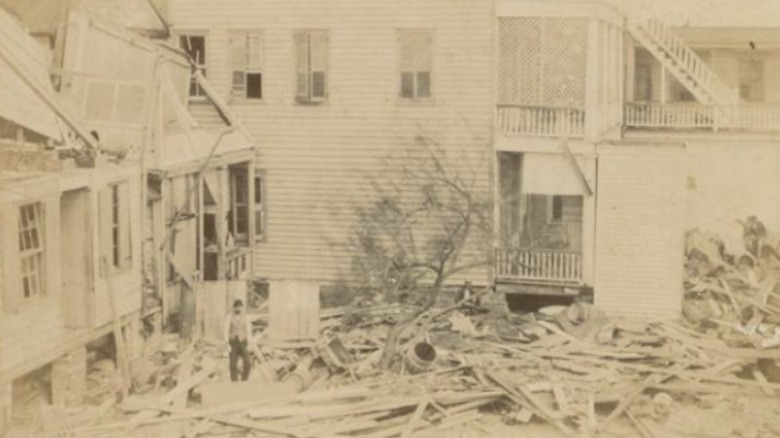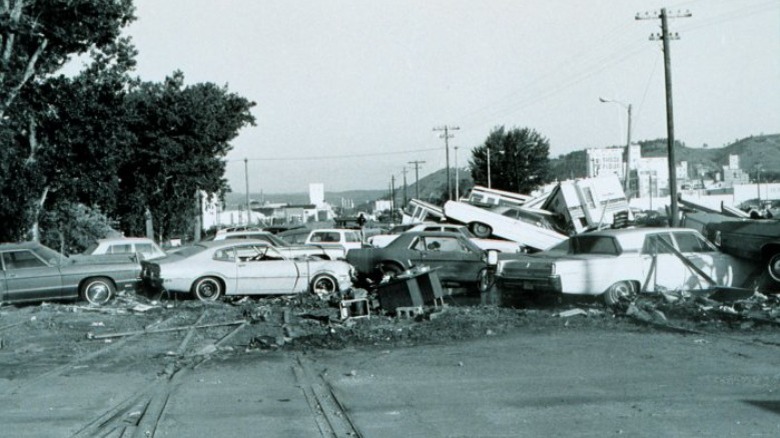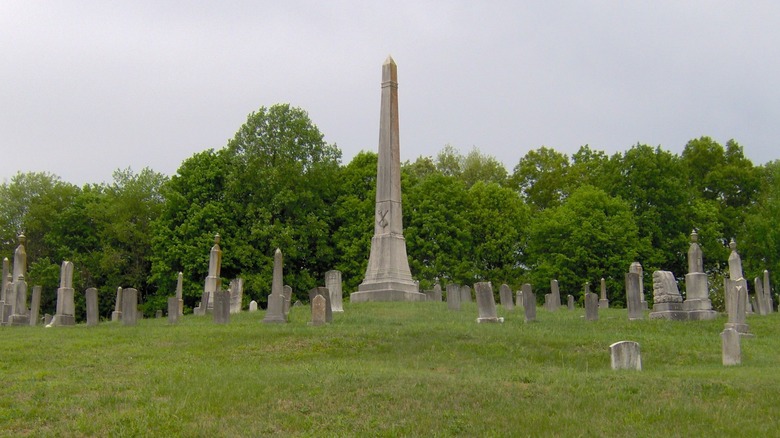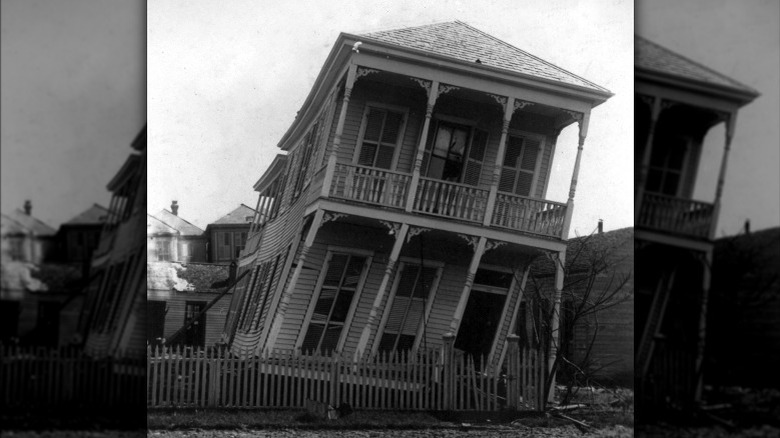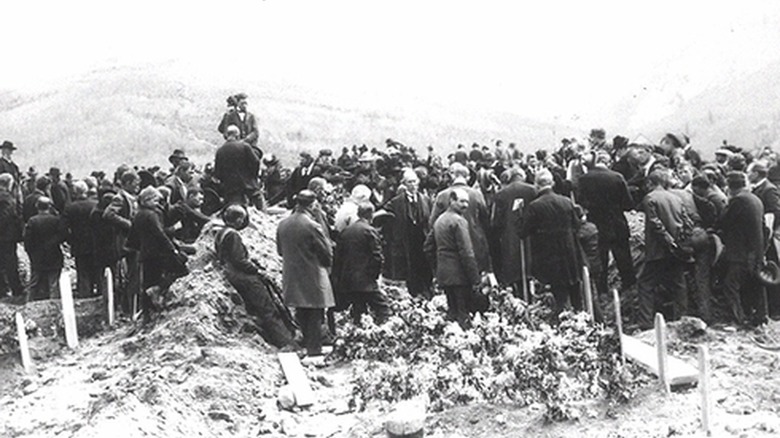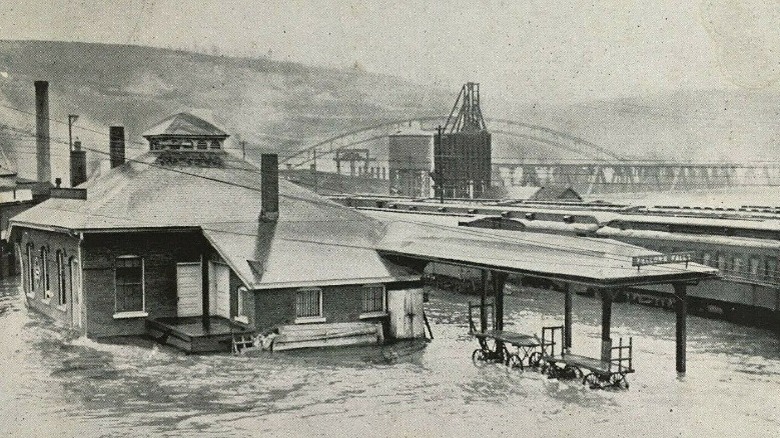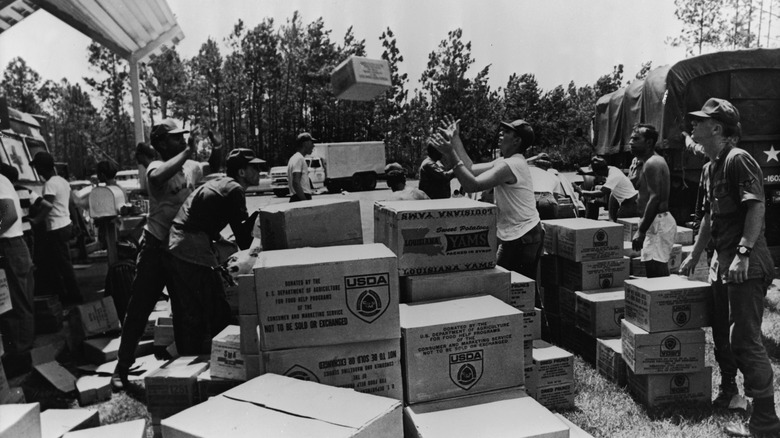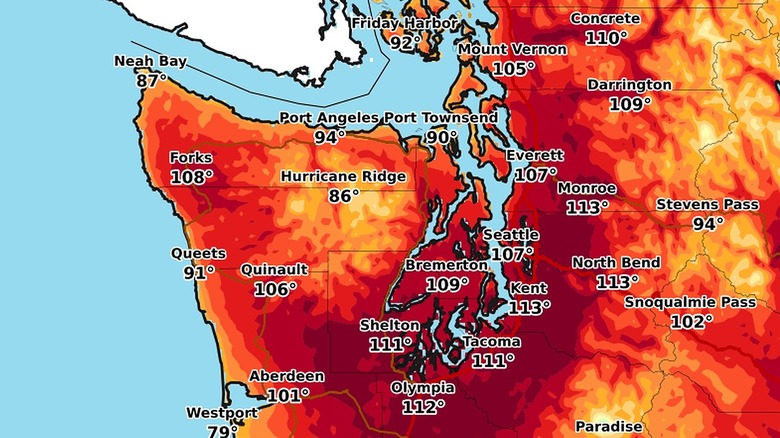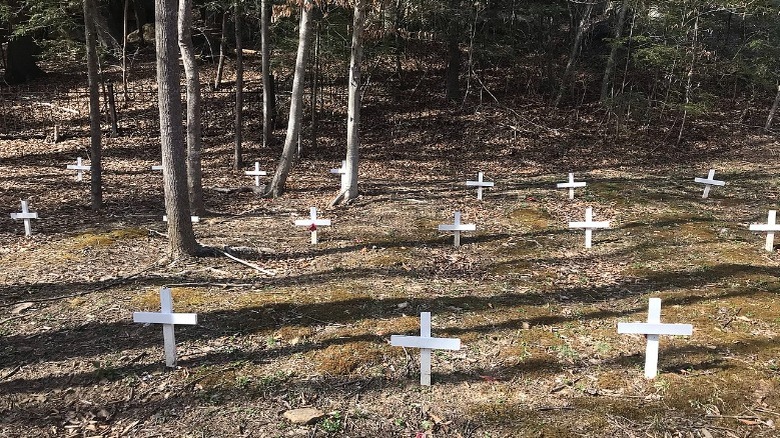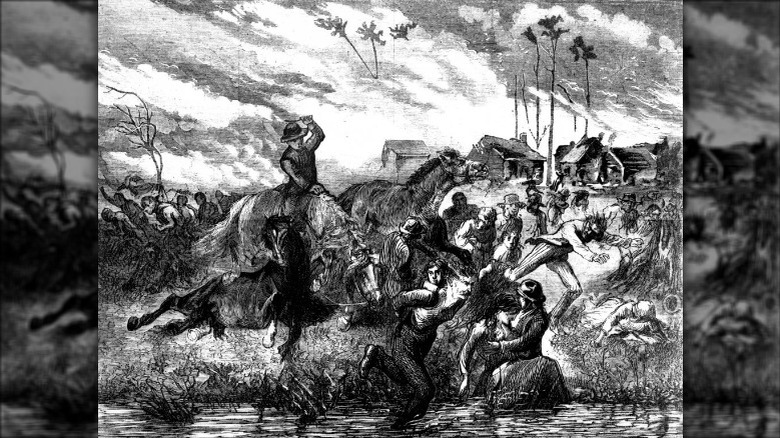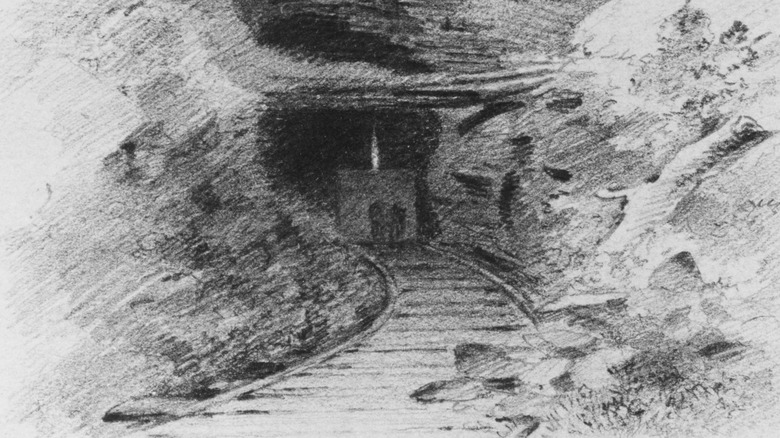The Deadliest Disaster In Every State
The deadliest disasters in the United States are moments of national tragedy, but many of them also reflect the unique risks of the time and place where they happened. Disasters of all kinds have shaped the histories of their respective states, wiping thriving communities off the map, changing safety standards, and even sending the country to war.
As described by PBR, the most common disasters in the United States are droughts, storms, and floods. Not all disasters are natural disasters, however. As described by CNN, many of the most devastating disasters in U.S. history have been mine collapses. Some states are prone to severe droughts and wildfires, while others are at risk of flash floods and blizzards (per US News.) If a state is located in "Tornado Alley" or on an earthquake fault, the same communities may deal with similar disasters over and over again.
These are the deadliest disasters in every U.S. state.
Alabama: Deep South Tornado Outbreak
On March 21, 1932, a series of tornadoes began leaving trails of devastation throughout the South. As described in "A History of Alabama's Deadliest Tornadoes: Disaster in Dixie," there were likely more than 20 tornadoes that day, costing hundreds of lives. The worst damage was in Alabama, where 268 people were killed by the twisters.
There was little warning about the disaster that was about to strike, because most people got their news by reading the newspaper or from a friend. It was extremely difficult for officials to communicate the impending danger. According to one survivor, whose family were farmers in Stanton, Alabama, the morning of the storm, there was no sign that the weather was about to become deadly. They only became aware of the impending storm when they heard a roaring sound from outside.
Reports (archived by the National Weather Service) describe entire buildings crushed and swept away. In the aftermath of the storms, tent cities had to be set up to provide temporary shelter for the thousands of survivors whose homes had been destroyed or damaged.
Alaska: Great Alaska Earthquake
Earthquakes are measured on a scale of one to ten. As described by Michigan Tech, earthquakes with a magnitude of 6.1 or higher can cause serious damage in populated areas. The earthquake that shook Alaska in 1964 had a magnitude of 9.2. As stated by History, this was the most powerful earthquake that has ever hit North America.
The disaster reportedly began with a strange grinding sound, followed by the ground opening up. The shaking lasted for four minutes. 15 people were killed by the earthquake itself, but soon, the violent shaking brought on tsunamis and landslides, which killed another 116 people (some in Oregon and California.)
As described by Life, the disaster, which took place on the Christian holiday Good Friday, permanently altered the physical landscape of some regions of Alaska, including Anchorage. In some areas, the land was raised as much as 30 feet.
Arizona: The Labor Day Storm
From September 4-5, 1970, tropical storm Norma drenched the state of Arizona with torrential rains. As noted by the National Weather Service, the amount of rainfall was record-breaking. In some places, more than 11 inches of rain came down in a single day. This led to deadly flash flooding – the worst in the state's history.
A total of 23 people were killed during the Labor Day Storm of 1970. As described by CNN, the fact that tropical storm Norma hit on a holiday weekend only compounded the dangers. Many people were celebrating the holiday outdoors. Campgrounds, in particular, became deadly locations, as sudden flooding washed away vehicles and campers alike. Fourteen of the 23 deaths took place at a single campground in Tonto Creek Basin. Buildings, roads, and bridges were also destroyed in the floods, costing the modern equivalent of more than $7.6 million in damages.
Arkansas: Flood of 1927
In 1927, the Mississippi River flooded, drowning 27,000 miles across seven states. As described in Smithsonian Magazine, hundreds of thousands were left homeless, and anywhere from 250 to 1,000 people may have lost their lives.
The disaster would come to be known as an example of the dangers of land mismanagement, particularly deforestation of the upper Midwest, which prevented the soil from properly absorbing rainfall. As described by Britannica, many of the levees along the Mississippi River collapsed It took months for the floodwaters to recede. An estimated 750,000 people's homes and belongings had been destroyed, and many of them were Black Americans who worked on plantations. The rescue efforts left these Black workers for last, leaving some stranded for days.
Radio news was still a relatively new thing, and stories of the devastation became an obsession all around the country. As noted by Britannica, the disaster led to widespread change within the country. Many Black Americans moved to cities in the North after the destruction, in what has been called the "Great Migration." Many became less likely to support Republican candidates, as the Republicans had been in power and seemed to have mismanaged the disaster.
California: San Francisco Earthquake
The earthquake on April 18, 1906 remains one of the most devastating earthquakes in recorded history. As detailed by USGS, the ground shook violently for almost a full minute and could be felt from Oregon to Nevada. Its epicenter was near the most populated city on the West Coast: San Francisco.
As described by History, the resulting tremors did terrible damage to the city and its population. The damage from the earthquake included falling power lines and ruptured water pipes. Fires spread throughout the city, which were extremely difficult to extinguish. As noted by the Library of Congress, fires burned for three days. Aftershocks continued doing damage to the city and the surrounding areas for days after. Exactly how many were killed in the disaster is unknown, but it is estimated that approximately 3000 people lost their lives, almost entirely within the city of San Francisco.
Colorado: Big Thompson Canyon flood
In July of 1976, the town of Estes Park, Colorado experienced more than a foot of rain in just four hours – the amount of rainfall that the area would usually experience in a full year (per Coloradoan.) As quoted in The Denver Post, people who were there described the air itself as being so full of water that it was hard to breathe. This bizarre rainstorm led to one of history's most devastating flash floods.
As described by the Coloradoan, the storm came at the worst possible time. It was almost the 100th anniversary of Colorado's founding, and about 3,500 campers had gathered to celebrate outdoors, in Big Thompson Canyon. Incredibly strong currents of water rushed into the canyon. According to survivors, the water rose too fast to react. One witness stated that in just 20 seconds, the water was waist-high. The flooding washed away vehicles, trees, and people. A total of 144 people are known to have been killed by the flood.
Connecticut: Hartford circus fire
The Ringling Bros. and Barnum & Bailey Circus was often called "The Greatest Show on Earth." As described by Britannica, it was an extremely popular traveling circus and was even granted special privileges to travel by train during World War II, because it was believed that the circus would raise U.S. morale. The show was performed under an iconic tent. Unfortunately, the big top had been weatherproofed using paraffin wax and gasoline, which is highly flammable.
There were 8,000 fans, many of them children, in the tent when the fire started. As described by Connecticut History, performers and workers noticed the impending disaster first and attempted to extinguish the flames, but it was too late. As described by History, pieces of the burning tent rained down on the audience. Many were able to escape, but when the ropes and poles supporting the tent were damaged, the entire thing collapsed, crushing many inside. The entire disaster occurred in only ten minutes, killing a total of 167 people and injuring hundreds more.
There was an investigation, and Ringling Bros. and Barnum & Bailey Circus had to pay millions of dollars in compensation. Multiple organizers were convicted of manslaughter.
Delaware: The Gale of 1878
In 1878, a powerful tropical storm swept across the country. As detailed by NOAA (via WeatherNation), the storm traveled from the western Caribbean, causing destruction from North Carolina to New England, still ripping the roofs off of 150 buildings as far north as New Jersey.
In Delaware, there was extensive damage to crops, infrastructure, homes, and businesses. As described by the National Weather Service, Delaware very rarely experiences hurricanes, but the Gale of 1878 brought massive amounts of rainfall, devastating winds, and deadly flooding across the state. Several people drowned in the sudden flooding. As described by WeatherNation, Delaware Bay was hit particularly hard. Four ships were sunk by the heavy winds, and another capsized. In total, it is believed that 18 individuals were killed in the state of Delaware. Approximately 70 others are believed to have lost their lives in the storm, as well as more than 175 deaths in storm-related shipwrecks (per Coastal Review.)
Florida: Okeechobee hurricane
In 1928, the area around Lake Okeechobee experienced unusually heavy rains over the summer, raising the water level by 3 feet (per American Experience.) That in and of itself was not a problem for the people of Florida, but then, on September 16, a hurricane hit the coast.
As described by The Weather Network, the hurricane is one of history's deadliest, doing damage from West Africa to Canada. In Guadeloupe, the storm devastated crops, destroyed homes, and killed 1,200 people. The death toll in Florida would be even higher.
As detailed by the National Weather Service, the area around Lake Okeechobee was particularly fertile, and a tremendous amount of Black migrant farm workers were working in the area. When 150 mph winds reached the already brimming Lake Okeechobee, floodwaters surged through the region. More than 2,500 people were killed in Florida, and the majority were workers in the areas around Lake Okeechobee.
Georgia: Tupelo-Gainesville tornado outbreak
In 1936 there was a deadly outbreak of 17 tornadoes in the Southeast. As described by Weather History, this led to flash flooding and fires. Two tornadoes reached the city of Gainesville and merged, forming one terrible storm.
Gainesville was home to the Cooper Pants Factory, which employed about 125 young women and girls. As described by the Georgia Historical Society, the storm caused the entire building to collapse. A fire started, trapping more than 70 workers inside. Many smaller buildings within the city burned after they collapsed as well, making it nearly impossible to know for certain how many people were killed, but as described by "Today in Georgia History," at least 200 people are believed to have died. Thousands of survivors were injured or left homeless in Gainesville.
In the aftermath of the disaster, President Franklin Delano Roosevelt visited Gainesville to see the destruction. His New Deal agencies worked to repair and rebuild some of the damage to the city.
Hawaii: Attack on Pearl Harbor
The U.S. government had imposed heavy sanctions and trade embargoes on Japan after the Nanking Massacre, and as noted by History, negotiations were going nowhere. It was believed that the Japanese government might order an attack on Singapore, the Dutch East Indies, or Indochina. Instead, the attack came in Hawaii.
The U.S. naval base Pearl Harbor, located close to the capital city of Honolulu, was not considered a likely target. However, almost the entire Pacific fleet was at Pearl Harbor, and destroying it before the war officially began would give Japan a massive advantage at sea. Hundreds of Japanese fighter planes attacked the U.S. naval base. More than 300 U.S. airplanes were destroyed, along with around 20 ships. The Pacific fleet was not destroyed, however, as the vital aircraft carriers were actually on the mainland. As described by the National WWII Museum, 2,403 people were killed during the attack, including 103 civilians, and 1,000 more were wounded. The following day, the United States declared war on Japan.
Idaho: Sunshine Mine disaster
The Sunshine Mine in Idaho is one of the most successful silver mines. On May 2, 1972, an apparently ordinary day of work at the mine turned deadly. As described by Spokane Historical, the first sign of the disaster was the smell of smoke. A fire, possibly caused by refuse near scrap timber, began on the air intake side of the mine, and was sending carbon monoxide throughout. Workers were sent to warn the others at the first sign of smoke, but for most of the miners, the warning wouldn't arrive before the smoke reached them.
Many of the exits were blocked by smoke, and after evacuating 80 men successfully, they almost completely stopped after the death of the worker who operated the machinery to haul the miners up was killed. By the time outside rescue crews arrived, 91 workers had been killed.
As described by the United States Department of Labor, the Sunshine Mine disaster revealed how dangerous working in mines was, and led to the Mine Safety and Health Act of 1977.
Illinois: S.S. Eastland Disaster
The Midwest isn't the area of the U.S. one immediately associates with luxury cruise lines, but in 1915, there was a small fleet of ships providing excursions around the Great Lakes and the Chicago River. One of them, the S.S. Eastland, had been in service since 1902. Unsteady from the start, the ship became more hazardous with each renovation, each one expanding its carrying capacity and speed at the cost of its stability. Still, the Eastland seemed to float well enough, and it was regularly approved by inspectors. "
The Eastland was one of five ships commissioned by Western Electric to ferry their workers and their families from Chicago to Indiana, part of a luxurious day out for the largely young and poor company staff. On the day of the disaster — July 24 — a steady rain was falling, and the weight of over 2,500 passengers caused the Eastland, the first ship to take off, to list to port. Within 10 minutes of taking off, it was obvious the ship was going to sink.
In the wake of the Titanic disaster, new laws mandated enough lifeboats for at least 75% of a ship's passengers, but ships like the Eastland were never designed to support that extra weight. There had also been no testing after the lifeboats were added. In a horrible piece of irony, those lifeboats helped contribute to a disaster that killed 844 people, more than the Titanic or the Lusitania. Compounding the casualties, 22 families were lost altogether.
Indiana: Circus train wreck
In 1918, two trains collided. One was an empty passenger train whose engineer had fallen asleep while driving. The other train wasn't moving at the time of the collision, but unlike the train that hit it, it was full of circus performers and showmen, including trapeze artists, strongmen, and clowns.
As stated by circus historian Steve Gossard (per IndyStar), history has been clouded by many myths about the tragedy. What is known is that a fire broke out after the train crash, trapping survivors inside. At the time, train cars were predominantly wood, which meant that they were highly flammable; 86 people were killed.
Many of the dead were never identified, both because the flames made the bodies difficult to identify and because many traveling with the circus were only known by their nicknames. Many of the headstones erected at the gravesite are labeled as unknown, but others are engraved with stage names or job titles, including monikers like "Smiley" and "4 Horse Driver."
Iowa: The Camanche tornado
It was an unusually warm June day in 1860 when the storm started. As described by WeatherNation, by the afternoon, two-inch hailstones were raining down on Eastern Iowa. The tornado's winds were reported to be so loud that it was impossible to hear anything else as the tornado ripped through the counties of Hardin, Linn, Jones, and Clinton. The majority of fatalities were in one community: Camanche, Iowa.
According to the Des Moines Register, Iowa has experienced multiple deadly tornadoes, but the 1860 Camanche Tornado remains the most deadly. As described in an 1860 report from The New York Times, the town was "literally blown to pieces," leaving few homes and businesses standing. Many were trapped inside when their homes collapsed, resulting in hundreds of survivors suffering terrible injuries, from broken bones to severe cuts. The storms leveled buildings, killed livestock, and killed approximately 140 people.
Kansas: Udall Tornado
Thanks to "The Wizard of Oz," many people already associate Kansas with twisters, but the history of tornadoes in the state is a devastating one. As described by KSN, the most deadly of the many storms in the state's history hit in 1955. It has come to be known as the Udall tornado, named for a community that it nearly wiped off the map.
On May 25, a tornado struck the town of Udall. Survivors reported there was so much dust it was impossible to breathe, and the sky was lit up by lightning. The entire south side of the town was obliterated, and 80 people were killed instantly, with seven later dying of their wounds – a total of almost 20% of the town's total population. Hundreds more were injured.
While there had been storms in Kansas and Oklahoma for three days, the local news had told the people of Udall that there wasn't likely to be a dangerous storm in their community that day. As detailed by the Kansas Historical Society, in the aftermath of the destruction, new methods of tracking and reporting on possible severe weather events were implemented to prevent future towns from being caught by surprise by a deadly storm hitting their town.
Kentucky: Beverly Hills Supper Club Fire
The Beverly Hills Supper Club of Southgate, Kentucky, had a long and storied history. First established as the Beverly Hills Club in 1937, the venue was Northern Kentucky's answer to the Las Vegas and New York entertainment circuits, attracting major acts such as Frank Sinatra and Liberace. But in 1977, the club became the site of one of the most tragic nightclub fires in history.
According to contemporary news reports, more than 3,000 people were crowded into the venue on the night of May 28, 1977 — a number that far exceeded the building's maximum occupancy. Sometime around 9 p.m., a teenage busboy took the stage in the club's Cabaret Room to announce that a fire had broken out and the building should be cleared. Any hopes of an orderly evacuation were dashed when the electricity failed and smoke began to fill the building. Patrons and employees attempting to escape were reportedly thwarted by locked fire doors and aisles blocked by tables and chairs. In one case, an "exit" sign led only to a closet.
When the fire's final victim died of her injuries the following March, the death toll stood at 165. An electrical malfunction was blamed for the disaster, but a task force assembled by Kentucky's governor discovered a stunning number of safety and code violations. A grand jury was impaneled in February 1978, with the governor predicting indictments. Shockingly, the jury ultimately blamed the victims for their own deaths, and no charges were filed. Still, a $30 million settlement was eventually awarded to the fire's victims, and the disaster led to nationwide fire safety improvements, including mandated sprinkler systems.
Louisiana: Great October Storm
In October of 1893, the Cheniere Caminada hurricane hit Louisiana and swept across the southeastern side of the state. It would soon be known as the Great October Storm. As described by Country Road Magazine, it would be one of the deadliest natural disasters in the history of the United States, killing thousands of people.
The hurricane first made landfall at a small fishing village called Cheniere Caminada. Their community was a unique and diverse one, including Creoles, Acadians, Italians, and Germans. The majority were Catholics who spoke French as a common language. Only about 1,500 people lived in Cheniere Caminada. When the storm hit, 779 were killed in the storm surge or in collapsing homes.
As noted by Louisiana State University, the storm swept on through Southeastern Louisiana, destroying homes and crops as it went. In total, it is believed that the "Great October Storm" killed approximately 2,000 people.
Maine: Onawa train wreck
In 1919 there was a horrific train accident near Onawa, Maine. As described by The New York Times, two trains collided head-on, killing 23 people and injuring 50 more. One of these was a freight train and the other was a train carrying nearly 300 immigrants from England and Scotland. Some of these were families, and several of those killed were young children.
It is believed that the accident was caused by a miscommunication: the freight train's engineer believed that the track was going to be empty. According to "Railroad Wrecks," the freight train's engineer was not aware that there would be three sections of the passenger train and thought that the freight train could go after the first two sections had passed.
Tragically, after the crash, the engine, the baggage car, and two passenger cars of the train caught fire. More than half of the survivors suffered terrible injuries, including broken bones.
Maryland: The Alum Chine explosion
In 1913, a 700-ton steamer called Alum Chime was loading up at Fort Carroll on the Patapsco River. Witnesses quoted in the Baltimore Sun described hearing a roar and seeing a sudden flash, hundreds of feet in the air. A mushroom cloud formed over the water. The explosion was so powerful that 100 miles away, people believed they had felt an earthquake. The ship's cargo had been dynamite, intended for use in building the Panama Canal, and without warning, it exploded.
Deadly debris rained down on the water. Many of those onboard were killed instantly, and those who survived were at risk of dying in the fires, in the water, or from the flying shrapnel. As noted by a report from the time (archived by UCR), it is believed between 40 and 50 people were killed in the explosion, and 60-75 more were injured – some of whom died of their injuries later.
Massachusetts: Boston Smallpox outbreak
The United States has a long history of devastating disease outbreaks. As noted by the CDC, the 1918 influenza epidemic killed approximately 675,000 people in the United States and more than 50,000,000 internationally. COVID-19 has killed approximately 1,075,779 in the United States and likely 3,000,000 worldwide, according to the World Health Organization. Not all epidemics spread across the entire country, however. In 1721, a deadly outbreak of smallpox broke out in the city of Boston, Massachusetts. The smallpox outbreak that came from a British ship in Boston Harbor would become the deadliest disaster in the state's history, killing approximately 850 people in the city. As described by Harvard's Science in the News, the disease could've been even more devastating.
Inoculation was rarely heard of in the Colonial Americas, but Puritan clergyman and writer Cotton Mather (pictured) had been told about it by a person he had enslaved: a West African man named Onesimus. Mather began to argue fiercely for inoculating the people of Boston against the deadly disease. Inoculation available in 1721 was far more dangerous than modern vaccination but still less dangerous than smallpox. Over time, inoculation against smallpox became increasingly standard in Boston, and mortality rates decreased.
Michigan: The Great Midwest Wildfires
The Chicago Fire famously destroyed three square miles of the city and killed hundreds. As described by the National Weather Service, it was not the only deadly fire in October of 1871. At the same time that Chicago was burning, deadly wildfires burned through the Midwest. Some of the largest of these fires were in Michigan. It is believed that more than 500 people were killed in the wildfires that struck Michigan, with the worst damage in Holland, Port Huron, and Manistee.
It's unknown exactly what started these terrible fires, which has led to legends about its origin, including the most popular story about a cow kicking over a lantern. In reality, while the exact cause is unknown, the weather conditions in the months leading up to October 8th had turned the Midwest into a tinderbox. Any spark had the potential to start a wildfire.
Minnesota: Cloquet fire
Drought conditions in 1918 Minnesota created the ideal environment to turn a spark into a deadly blaze. As described by the National Weather Service, northern Minnesota was experiencing drier weather than it had in half a century. When the wind caught a spark from a train traveling through the state and blew it into the water-deprived pine forests, a fire began. It would become the deadliest in Minnesota history.
As described by East Bay Times, the dried-out trees caught fire and the entire forest became a blaze. Entire towns, including Cloquet, Moose Lake, and Kettle River were destroyed, and severe damage was done to the city of Duluth. Those caught in the path of the wildfire had few options for escape. Some attempted to drive away from the fire, but they weren't fast enough, leading to deadly car crashes as the fire consumed the vehicles. Some managed to escape by train, while other survivors were forced to remain in rivers and lakes until the flames died down. As stated by the National Weather Service, it is believed that approximately 1,000 people were killed.
Mississippi: Hurricane Katrina
In August of 2005, the United States was hit by an extremely powerful and deadly storm known as Hurricane Katrina. As described by the National Weather Service, the storm did incredible damage across five states. While the majority of coverage focused on the devastation in Louisiana, where over 1,500 people were killed (per CNN,) the 238 deaths within Mississippi made Hurricane Katrina the state's biggest catastrophe.
Hurricane Katrina brought 175 mph winds and a deadly storm surge to Mississippi. As described by WLOX, many of those who evacuated before the storm survived, but returned home to find that their friends and neighbors had been killed and their houses had been completely obliterated by the storm, leaving them with almost nothing.
Hurricane Katrina remains one of the most horrendous storms to ever hit the U.S., having killed 1833 people in total and caused the equivalent of more than $158,000,000,000 worth of damage.
Missouri: Joplin tornado
Missouri is no stranger to deadly tornadoes. As noted by KY3, the city of Joplin is just outside what is known as "Tornado Alley," the region of the United States most prone to twisters. In the 1970s, multiple storms ripped through the city of Joplin, killing several people and doing millions of dollars worth of damage. The deadliest in United States history, the infamous 1925 Tri-State Tornado, began in Missouri – but, a 2011 tornado known as the Joplin tornado actually cost more lives in Missouri. It, too, would be a record-breaking storm. According to the National Institute of Standards and Technology, it was the single deadliest and most expensive tornado ever recorded in the United States.
While the buildings in Joplin were up to code, they were not prepared for the tornado's shocking 200 mph winds. Thousands of buildings were destroyed in the storm. Billions of dollars worth of property, from homes to hospitals, were wrecked. It is believed that the Joplin tornado killed 161 people and injured more than 1000 others.
Montana: Speculator Mine disaster
Butte, Montana, in 1917, was an industrial city with one of the world's largest mining operations. The community was a unique and diverse one where more than 30 languages were regularly spoken. When World War I made copper more valuable, shifts got longer and safety precautions were ignored. A rotating force of 14,000 workers was down in the mines at all times. They were headed for disaster.
More than 400 workers were on the night shift on June 8, 1917, when an enormous electric cable fell deep into the mine. The cable's insulation included highly flammable paraffin paper, and when one of the workers brought his lantern too close, it began a deadly fire. Smoke flooded the mine, suffocating the miners trapped inside. Tragically, 168 workers were killed.
As described by Arnon Gutfeld's "The Speculator Disaster in 1917: Labor Resurgence at Butte, Montana," this catastrophe sparked a revolution in Butte. After the disaster, the mine was brought to a halt when the workers went on strike to protest the labor conditions that had led to the calamity.
Nebraska: Easter tornadoes
It was early evening on March 23, 1913, and many of the people around Omaha, Nebraska were celebrating the Easter holiday. No one was expecting a storm, but suddenly the area around Ralston and Omaha was hit by devastating storms. As described by the Omaha World-Herald, an enormous storm carved a 4½ mile trail through the city of Omaha and completely destroyed the new city of Ralston. Thousands of homes were damaged or completely destroyed, hundreds were injured, and over 100 people were killed.
The tornado that struck Omaha and Ralston was not the only one to hit the state of Nebraska that day. As described by "The Iowa-Nebraska Tornadoes of Easter Sunday, 1913," five tornadoes traveled across the state in strangely parallel paths. Each was no more than 25 miles away from the ones on either side. One of these was the tornado that hit Omaha. The others struck Craig, Yutan, and parts of Iowa. As noted by the Omaha World-Herald, 65 people were killed in these other storms, and hundreds more were injured.
Nevada: MGM Grand Las Vegas Fire
On the morning of November 21, 1980, a fire began in the Las Vegas hotel and casino: the MGM Grand. As noted by Nevada Public Radio, the fire, which began in the hotel deli, would be the deadliest in Nevada State, killing 87 people.
Black smoke poured out of the building. More than 2,000 people were inside the hotel at the time the fire began. Many had to be evacuated by helicopter. Ironworkers set up scaffolding to help hotel guests escape out the windows. Two hundred firefighters worked to extinguish the deadly fire. The rescue efforts might have been more successful if there had been adequate fire safety precautions. There were no smoke detectors or fire alarms to alert the guests and staff to the danger. Most areas in the hotel and casino did not have sprinklers, either.
In the aftermath of the fire, relief funds and donations of food and clothes had to be set up for the thousands of workers who had been employed at the casino. As described by the Las Vegas Review-Journal, the disaster sparked reforms. After a second fire started in another Las Vegas hotel, it became obvious that new safety standards were needed to prevent future tragedies.
New Hampshire: The Great New England hurricane of 1938
In 1938, a devastating category 2 hurricane struck New England. Winds up to 163 mph whipped through New Hampshire. As described by WMUR, no one knew how serious the storm was going to be before it reached the shore. As described by PBS's American Experience, the storm led to terrible flooding and caused a fire in the state of New Hampshire.
Thirteen people were killed in New Hampshire, but the damages in other states, like Rhode Island, were just as bad or worse. Throughout New England, a total of 564 people were killed, 1,700 were injured, and 2 billion trees, 1 in every 3 in the region, were obliterated. The total damages are believed to have cost the modern equivalent of more than $,454,000,000. As noted by the National Weather Service, almost 9,000 homes and 2,600 fishing boats were destroyed, and thousands more were damaged.
New Jersey: Hoboken Docks fire
In the year 1900, a fire that started in a bale of cotton spread to the Hoboken docks. As described by several newspaper reports from July of 1900 (quoted by The History Guy), the resulting blaze would cost hundreds of lives and come to be known as the Hoboken Horror. As described by the Library of Congress, within 3 hours, the fire had spread a quarter of a mile, killing more than 300 people.
The Hoboken docks were a vital part of the New Jersey and New York economy, and the storage buildings were tightly packed with goods of all kinds. How the cotton caught fire is still unknown, but it soon grew into an inferno. The bales happened to have been stored near barrels of oil, which exploded. Within several minutes, the Hoboken Fire Department arrived to fight the flames, but the fire moved fast. A 1900 report from the Bamberg Herald (recounted via The History Guy) described how the workers on the pier were trapped by the rapidly approaching blaze. Many drowned attempting to escape.
New Mexico: Dawson mining disaster
In 1913, the town of Dawson, New Mexico was a coal mining town. As detailed by the Santa Fe New Mexican, the majority of the workers who lived there were recent immigrants from Italy, Greece, Mexico, and many other countries. In general, they lived in separate communities within Dawson.
On October 22, there was a sound like a gunshot and then the earth shook under the town of Dawson, New Mexico. Suddenly, a jet of flame shot 100 feet out of the entrance to the Stag Cañon coal mine. An explosion had been caused by coal dust within the mine.
About 25 miners made it to the exit, but hundreds of other workers were trapped inside. Inside the mine, many of the workers were dead, and debris was still falling. It was so dangerous that two members of the rescue team were also killed. In total, it is estimated that 263 people were killed.
New York: 9/11 attacks
On September 11, 2001, two passenger planes, hijacked by the extremist group al Qaeda, struck the World Trade Center in New York City. A staggering 2,977 people were killed in the attack, and as stated by USA Today (via Mount Sinai), approximately 10,000 New Yorkers who were near the Twin Towers, particularly first responders, have since been diagnosed with cancer as a result of their exposure to the toxic smoke from the burning buildings and planes. It is believed the number of people who have or will die as a result of exposure to the disaster will eventually be greater than the casualties on 9/11.
As described by The Guardian, These attacks were unprecedented in the United States and sparked intensive counter-terrorism measures often referred to as the War on Terror. In the United States, there was an increase in surveillance of civilians, particularly Muslim Americans. As described by History, it also sparked two decades of war. In an operation referred to as Enduring Freedom, the United States sent military forces into Afghanistan, with the stated goal of removing the Taliban from power and breaking up terrorist activity controlled by Osama bin Laden. The U.S. removed the last of its troops from the country in 2021, and as described by the Council on Foreign Relations, the Taliban returned to power.
North Carolina: The Enigma and Carolinas tornado outbreaks
In 1884, converging winds in the Southeast developed into a devastating tornado outbreak that would come to be known as the Enigma Outbreak. As described by WeatherBug, more than 37 tornadoes hit six states: Mississippi, Alabama, Georgia, North Carolina, South Carolina, and Kentucky. In total, it is believed that the storms killed 167 people throughout the country. As noted by the National Weather Service, at least 50 of those casualties were in North and South Carolina, making the tornadoes the deadliest disaster to ever strike the state.
A full century later, in 1984, an extremely similar tornado outbreak hit North Carolina again. In total, the 1984 outbreak sent 24 storms ripping through North Carolina, South Carolina, and Georgia, killing almost 60 people and injuring around 1,250 more. The state of North Carolina experienced the worst damage as 11 individual tornadoes hit the state and took the lives of 42 people.
North Dakota: The Schoolhouse Blizzard
January of 1888 had been unusually warm for the season in North Dakota, so no one was prepared for a devastating snowstorm. As described by History, a sudden blizzard blew in from Canada, bringing snow and wind, and temperatures of -40°F. According to reports from the time, the temperature in some areas dropped more than 100°F in a single day.
People had no time to prepare, and the storm killed people and livestock throughout the state. Farmers suffered terrible losses. As described by Smithsonian Magazine, American agriculture was forever changed after the disaster. The blizzard is believed to have killed 235 people. The storm became known as the Schoolhouse Blizzard, because the majority of those who lost their lives were children attempting to make their way home from school through the snow. As described by History, some of these children were kept safe by their teachers. One of these heroic figures is a teacher named Minnie Freeman, who helped her entire class get to safety after the roof of the schoolhouse was ripped clean off. Others were rescued by loving parents who had to dig through feet of snow to find the school.
Ohio: Great Flood of 1913
In March of 1913, a number of deadly weather events occurred nearly simultaneously in the Midwest. First came terrible ice storms and heavy winds. Next, devastating tornadoes swept through. Finally, the water started to rise. As described by Case Western Reserve University, in the state of Ohio, it would be the flooding that would be so deadly.
As noted by Ohio History Central, flooding is not unusual in Ohio, but the heavy rains from the many storms that hit the state at once in 1913 were unprecedented. During the storms, approximately 11 inches of rain fell on Ohio in just five days – as much as the region would typically get in three months. The water passed the banks of rivers and streams all over the state, smashing through levies and sending floodwaters rushing through towns and cities.
Many people died in the flood, and others were killed by the damage the water caused. In the city of Dayton, which experienced particularly terrible flooding, gas lines broke, causing terrible fires. In total, it is believed that at least 428 people were killed.
Oklahoma: Tulsa Race Massacre
Tulsa, Oklahoma was once home to "Black Wall Street." As detailed by the Tulsa Historical Society and Museum, the city neighborhood known as the Greenwood District was an extremely successful business district where Black Americans lived and worked. In 1921, the community was attacked.
A Black teenager named Dick Rowland got on an elevator that was operated by a white woman named Sarah Page. As noted by History, the police would later determine that Rowland accidentally stepped on her foot. When Page shouted, Rowland ran away. A rumor that he had sexually assaulted Page spread, and the police arrested Rowland. The Tulsa Tribune made the case a front-page story, and a group of enraged white people, many armed, demanded that the police hand Rowland over to the mob. When the police refused, the group began to riot. Unable to get their hands on Rowland, they attacked the Greenwood district instead.
Although the police had refused to give Rowland to the white mob, some of the rioters were actually deputized and given weapons by city officials (per History.) The rioters attacked Greenwood, looting and burning Black-owned businesses and community buildings, including churches, hospitals, and schools, burning down more than 1,200 homes, and killing as many as 300 people.
Oregon: The Heppner Flood
In June of 1903, a sudden thunderstorm barraged the little farming town of Heppner, Oregon with hail and heavy rain. As detailed in Joann Green Byrd's "Calamity: The Heppner Flood of 1903," while the hail itself was not deadly, the stones were large enough to make a cacophonous sound on the roofs of the town folks' homes. The noise itself was harmless, but it prevented those sheltering indoors from hearing another sound: the approaching flood.
The flash flood rushed through the town. In only an hour, the surging waters killed 238 people – nearly 20% of the total population of the little community of Heppner. The flood waters also contaminated the drinking water for at least two other communities in the surrounding area. A 1903 report from the Los Angeles Herald places the death toll at more than 800 people. Determining exactly how many people had lost their lives in the flooding was extremely difficult, because the raging waters carried the bodies far away from where they had been killed, and often buried them in mud and debris.
Pennsylvania: Johnstown Flood
In the year 1840, an enormous rock and dirt dam was built near the town of Johnstown, Pennsylvania. As described by History, it was the largest dam in the United States at the time, and its construction created the largest man-made lake. By 1889, the canal system that the dam was a part of had mostly been replaced by trains, so the dam was rarely inspected or maintained. For the 30,000 people living in Johnstown, this would bring calamity.
At the end of May, the region around Johnstown experienced unusually heavy rain. An engineer noticed that one of the passages that allowed water to move through the dam in a controlled way had become clogged, and he was unable to clear it. He attempted to warn the people of Johnstown, but the telegraph lines had also been damaged, and he was unable to reach the town in time. The dam collapsed, and the entire contents of the lake (estimated to be approximately 4.8 billion gallons) surged into Johnstown. More than 2,000 people were killed, both by the flood and by fires that started in the floating debris.
Rhode Island: The Station Nightclub Fire
It was a Thursday night in February in the year 2003, and hundreds of people had gathered in the Station Nightclub in West Warwick, Rhode Island to see a concert from 1980s rock band Great White, famous for their hit "Once Bitten, Twice Shy." As described by CBS News, as the band came onstage to start their act, their manager set off some pyrotechnics: four fireworks. This sparked a deadly fire.
Neighbors in West Warwick had complained about the sound coming from the nightclub, so the club's owners had the walls and at least one of the doors lined with soundproofing foam. Unfortunately, that foam was highly flammable, and as soon as the fireworks went off, it caught fire. Flames spread up the walls on both sides of the stage. One hundred people were killed in the blaze, and 200 more were injured. The band's manager pleaded guilty and both owners of the Station Nightclub pleaded no contest to 100 counts of misdemeanor manslaughter.
South Carolina: Sea Islands hurricane
In 1893, a devastating storm struck the Sea Islands off the coast of Georgia and South Carolina. As described by the National Parks Service, the hurricane is often described as one of the most deadly in the history of the United States, and the death toll may be even higher than was previously known.
In the late 1800s, Beaufort County, which contains multiple Sea Islands in South Carolina, was the primary source of phosphate in the United States. As described by the Federal Reserve Bank of Richmond, phosphate was used to make fertilizer, and mining it could provide workers with a reasonable income. The community in Beaufort was mostly made up of Black families, many of whom had formerly been enslaved. The phosphate industry in Beaufort County was highly successful, and many of the Sea Islanders in Beaufort County also had thriving cash crops.
The storm would obliterate this thriving community, ruining crops, destroying the boats needed to ship phosphate, leaving more than 30,000 homeless, and killing at least 2,000 people. In the aftermath of the hurricane, an outbreak of malaria and starvation killed many more.
South Dakota: The Black Hills flood
On June 9, 1972, South Dakota experienced unusually serious thunderstorms. As described by the National Weather Service, the storms were expected to be severe, but no one knew how deadly the flooding caused by the heavy rainfall would be. Between 7 pm and 8 pm, the water level in multiple creeks was reported to be rising, breaking dams and flooding out into the surrounding area. At 10:30 pm, officials were recommending everyone who lived in lower elevation areas should evacuate. Before 11 pm, the Canyon Lake Dam broke, and even more floodwaters surged into populated areas – particularly Rapid City. The rain continued overnight.
As described by CBS News, the damage in Rapid City was catastrophic. The flash flood caused the modern equivalent of more than 1 billion dollars worth of damages, including the destruction of 15 bridges, thousands of cars, and 1,300 homes (per NWS.) Thousands were injured and 238 people were killed in the flood, making it one of the deadliest flash floods in the history of the United States.
Tennessee: Fraterville Mine disaster
The Fraterville Mine was at one time considered an incredibly safe place to work. As described by the Coal Creek Watershed Foundation, Fraterville was one of several successful mines in Tennessee which did not rely on unpaid prison labor, but instead hired experienced miners who were paid based on the amount of coal they could mine. The workers were able to purchase land and build homes in the local community, where they lived alongside their fellow workers and their families. Tragically, on May 19, 1902, an explosion killed almost all of the men who had lived and worked at Fraterville.
As described by the Tennessee Historical Society, methane gas likely built up inside the mines, and a spark from a worker's light, possibly combined with airborne coal dust, caused the deadly blast. Many miners were killed by the explosion, while others were suffocated by the gas. In a single day, the community around Fraterville had been destroyed. As noted by the Coal Creek Watershed Foundation, one man left for work slightly late to put on a warmer jacket and ended up being the only man in the community still alive. The other 216 men who worked in the mine were killed, leaving behind grieving families.
Texas: Galveston Hurricane
Galveston Island is located off the coast of Texas. In the year 1900, it was a popular vacation spot. As stated by History, on September 8, 1900, a Category 4 hurricane struck the island. The storm would become the deadliest in U.S. history, killing between 6,000 and 12,000 people. The storm was powerful, but some have argued that the real reason that the disaster was so deadly was a severe lack of information.
The official reports stated that the storm was going to hit Florida and then travel north to New England. As described by History, The Weather Bureau in Washington, D.C. had only existed for 10 years at the time of the Galveston Hurricane, and hurricanes were not very well understood – and would not be till the 1940s. The bureau's director had told local weather forecasters not to issue hurricane warnings without communicating with the Bureau in Washington. By the time observers at The Weather Bureau realized their mistake, it was too late to warn Galveston of the impending disaster.
Utah: Scofield mine disaster
Just before 10:30 am on May 1, 1900, the sound of a blast echoed through Scofield, Utah. As described by Utah's Department of Cultural & Community Engagement, most of the townspeople believed that the sound was a firework celebrating Dewey Day, the anniversary of the 1898 naval battle of Manila. In reality, there had been a terrible explosion at the nearby Pleasant Valley Coal Company mine.
Some of the miners who had been inside the mine at the time of the blast had survived, but they were trapped inside with toxic fumes and running out of oxygen. In total, 200 workers were killed. As described by the John Hutchings Museum, many at the time believed that the mine had been mismanaged and there were not enough safety procedures. To the despair of the miners' grieving families, the Pleasant Valley Coal Company was not held accountable by the official investigation. Many of the surviving workers went on strike, and most people living in Scofield moved away. Unable to find experienced miners willing to work at the mine, it finally shut down for good in 1923. Today, the town of Scofield is currently the smallest in the state of Utah, with less than 25 people still living there.
Vermont: Great Vermont Flood
The fall of 1927 was an unusually rainy one for Vermont. As noted by WeatherBug, in October, the state had an average of 150% more rain than usual, and in some regions, as much as 300% more. By November, the ground was saturated and the rivers and streams were full. On November 2, it rained all day and all night. On November 3, the people of Vermont would experience the worst natural disaster in the state's history.
Dams were broken by the sudden surge of water, with catastrophic effects. As stated by the Vermont Historical Society, in Bolton, Vermont, the Bolton Valley Dam broke, leading to 19 deaths in a single boarding house. Vermont's infrastructure was no match for the rushing water, which damaged hundreds of miles of roads and railroad tracks and destroyed more than 1,200 bridges. The total damages across the state cost the modern-day equivalent of more than $475,000,000. Across the state, 84 people lost their lives in the flooding. Fifty-five of those killed were located in the Winooski River Basin.
Virginia: Hurricane Camille
Only four Category 5 hurricanes have ever hit the continental U.S. One of the most violent was Hurricane Camille. As described by the National Weather Service, exactly how strong the 1969 hurricane's winds were is still unknown, because the storm destroyed the instruments designed to measure it. Across the United States, Hurricane Camille was responsible for 256 deaths. As stated by NOAA, Camille struck Mississippi, Tennessee, and Kentucky, but then made an abrupt turn, traveling over West Virginia and Virginia. By that time, it was no longer a hurricane, only a tropical depression, but it was still strong enough to become the deadliest natural disaster in Virginia's history.
Camille brought as much rain as Virginia was used to in six months in a single night. As stated by 13 News Now, this knocked out the power, destroyed roads and railroads, and damaged almost 1,000 buildings across the state. There were deadly floods and mudslides. In total, more than 150 people were killed in Virginia alone.
Washington: 2021 heat wave
In the summer of 2021, the Pacific Northwest experienced a record-breaking heatwave that cost hundreds of lives. As stated by the AP, at least 112 people were killed in the state of Washington alone. While the majority of the deaths occurred in densely populated areas, like the city of Seattle, where temperatures reached 108°F, 20 counties in Washington reported deaths due to extreme temperatures.
As stated by the Washington State Department of Health, the temperatures in this heat wave were high enough to present a very high risk of illness for a large percentage of the population. Individuals who are more sensitive to heat, such as the elderly and young children, and those who were unable to hydrate and remain in cool areas, were at particular risk. Experts have warned that potentially deadly heat waves like the one that occurred in the Pacific Northwest in 2021, are likely to happen more frequently and last longer as the climate crisis progresses.
West Virginia: Hawk's Nest Tunnel Disaster
West Virginia has experienced more than its fair share of industrial disasters, but the Hawk's Nest Tunnel Disaster is among the worst of its kind in United States history. In 1930, an enormous, three-mile tunnel was being built. As described by the National Parks Service, its path was directly through a mountain.
Hundreds of unemployed people were brought in to bore a hole through solid rock. The conditions in which the workers labored in were horrendous. They were using a dry drilling technique, which sent large quantities of dust into the poorly ventilated tunnel where the men were working. If someone worked there for too long they could come down with a mysterious sickness that came to be known as "tunnelitis." In truth, it was silicosis.
As described by the NHS, silicosis is a horrendous lung disease that comes from inhaling silica dust – which the rock the workers were tunneling through contained. The dust caused serious inflammation and scarring in the lungs. As stated by the NPS, 2,900 men worked in the tunnel, and 746 of them were killed by silicosis.
Wisconsin: Peshtigo Fire
On October 8, 1871, multiple devastating fires burned through the United States. On the same night as the infamous Chicago fire and the Great Midwest Fires decimated Michigan, an even deadlier blaze was taking place in Wisconsin: the Peshtigo Fire. As noted by History, the Peshtigo fire killed more than 1,000 people, making it the worst in the history of the United States.
Peshtigo was a lumber town, home to an enormous sawmill. The buildings were made of wood and the roads were coated with sawdust. The people of Peshtigo understood how dangerous a fire could be, particularly as the season had been unusually hot and dry, and they attempted to prepare for a possible disaster, but no one was ready for how deadly the fire would be. A fire began somewhere in the woods near the small town of Sugar Bush – which was completely obliterated by the flames. When it reached Peshtigo, bringing with it temperatures of up to 2,000°F, it killed approximately 1,200 people.
Wyoming: Hanna mine disaster
Hanna, Wyoming was a coal town. As described by the American Heritage Center, the Union Pacific Coal Company opened multiple mines around the town, and the workers lived in Hanna. On the morning of June 30, 1903, coal gas in one of the mines ignited, causing a deadly explosion that trapped 200 men inside the mine. It is believed that a vein of coal caught fire and couldn't be extinguished. The tunnels flooded with toxic smoke. The fire burned for days underground, making attempts to save survivors incredibly dangerous.
Fellow miners and their families from the town of Hanna worked tirelessly to try to free those trapped inside the mine. Experienced firefighters and doctors were brought in to help. In the end, however, only 46 people, who happened to be working near an air shaft at the time of the disaster, were able to escape. Those near the explosion were killed instantly, while others were killed by a cave-in and others suffocated. In total, 169 people were killed.
